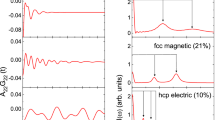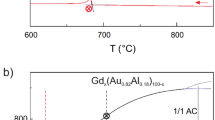Abstract
IN an earlier note1 the determination of the unit cell and space-group of the phase which exists in equilibrium with the restricted solid solution of cobalt in aluminium was described. The ideal composition was shown to be represented by the formula Co2Al9. The space-group is P21/a, and recent work has given more accurate values of the parameters, as follows : a = 8·5565 ± 0·0005 A., b = 6·290 ± 0·005 A., c = 6·2130 ± 0·0005 A., β = 94·760° ± 0.005°.*
This is a preview of subscription content, access via your institution
Access options
Subscribe to this journal
Receive 51 print issues and online access
$199.00 per year
only $3.90 per issue
Buy this article
- Purchase on Springer Link
- Instant access to full article PDF
Prices may be subject to local taxes which are calculated during checkout
Similar content being viewed by others
References
Parker, A. M. B., Nature, 156, 783 (1945).
Pauling, L., J. Amer. Chem. Soc., 69, 542 (1947).
Raynor, G. V., Phil. Mag., 38, 770 (1945).
Pauling, L., Phys. Rev., (11), 54, 899 (1938).
Author information
Authors and Affiliations
Rights and permissions
About this article
Cite this article
DOUGLAS, A. Structure of Co2Al9. Nature 162, 565–566 (1948). https://doi.org/10.1038/162565b0
Issue Date:
DOI: https://doi.org/10.1038/162565b0
Comments
By submitting a comment you agree to abide by our Terms and Community Guidelines. If you find something abusive or that does not comply with our terms or guidelines please flag it as inappropriate.



